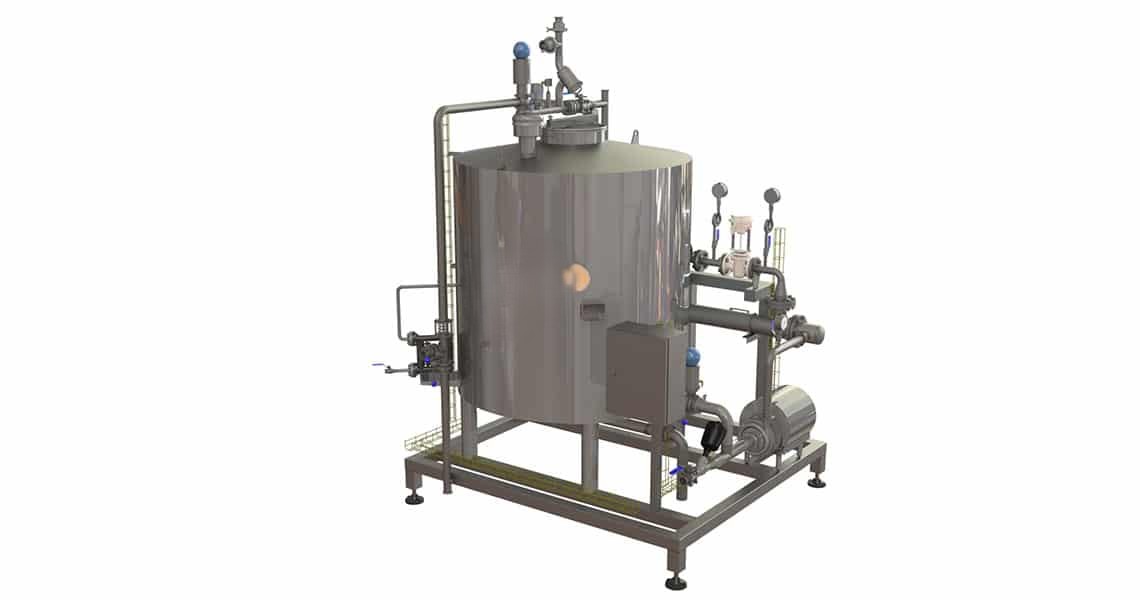Introduction
CIP System Heat Exchangers is an automated method of cleaning the internal surfaces of process equipment such as tanks, pipes, heat exchangers, pumps, and valves — without disassembling them.
This system circulates cleaning chemicals, rinse water, and sanitizers through the process lines and equipment under carefully controlled conditions, ensuring hygiene and safety without disrupting the system’s assembly.
Key Purposes:
- Remove product residues (fat, protein, sugar, starch)
- Eliminate bacterial or microbial contaminants
- Maintain equipment efficiency and operational safety
- Prevent cross-contamination between production batches
- Reduce manual labor and downtime
Role of Heat Exchanger in CIP System Heat Exchangers
The heat exchanger is a core component of the CIP loop because each cleaning step requires a specific temperature. Without it, chemical cleaning efficiency drops dramatically.
In-Depth Functions:
Temperature Control:
- It heats cleaning fluids like water, caustic soda, or acid solutions to a precise, pre-set temperature (often between 60°C to 90°C).
- In some stages, it may also cool solutions before reuse or disposal to avoid system strain or adhere to environmental regulations.
Quick Heating/Cooling:
- Cleaning processes are time-sensitive in industrial plants. The heat exchanger allows rapid heating of large fluid volumes within a short duration to maintain CIP cycle efficiency.
- Immediate cooling is also possible after high-temperature cleaning stages to avoid thermal shock to delicate equipment.
Energy Recovery:
- Many modern systems use heat recovery loops, where outgoing hot cleaning solutions transfer heat to incoming cold fluids through a heat exchanger.
- This reduces the overall heating demand on boilers or steam systems, lowering energy costs.
Key Features of CIP System Heat Exchangers
Hygienic Design
- Constructed using sanitary-grade materials like AISI 316L stainless steel with smooth, polished surfaces (often Ra ≤ 0.8 μm) to minimize biofilm formation and contamination risks.
- Avoids crevices or dead spots where bacteria could accumulate.
CIP-Compatible Gaskets and Seals
- Uses food-safe, chemical-resistant gaskets like EPDM, PTFE, or silicone that withstand temperatures up to 150°C and resist caustic, acid, and sanitizer attack.
High-Temperature and Pressure Resistance
- Designed to operate efficiently under elevated temperatures (up to 150°C or more) and pressures, which are typical during hot caustic and sanitizing stages.
Easy to Dismantle and Inspect
- Particularly for plate heat exchangers, which can be disassembled for periodic validation, integrity checks, or internal CIP coverage testing — especially important for regulated industries.
Types of Heat Exchangers Used in CIP System Heat Exchangers
Plate Heat Exchangers (PHE)
Structure: Thin, corrugated stainless-steel plates stacked and clamped together, forming alternating channels for hot and cold fluids.
Advantages:
- High heat transfer coefficient due to large surface area and turbulent flow.
- Easy to dismantle for internal cleaning, inspection, or plate replacement.
- Compact footprint, ideal for limited-space plants.
- Widely used in dairy, breweries, and juice plants where hygiene is critical.
Shell and Tube Heat Exchangers
Structure: Consist of multiple tubes enclosed within a shell. One fluid flows through the tubes; another flows through the shell.
Advantages:
- Handles high pressures and temperatures — ideal for pharmaceutical and dairy processes.
- Easy mechanical cleaning of tube interiors.
- Durable and reliable for harsh chemicals.
- Can accommodate larger volumes of cleaning fluids than plate types.
Conclusion
CIP System Heat Exchanger plays a pivotal role in maintaining hygiene, safety, and operational efficiency across industries like dairy, beverages, pharmaceuticals, and food processing. By ensuring precise and consistent temperature control of cleaning solutions, it enhances the effectiveness of cleaning agents, accelerates CIP cycles, and prevents contamination risks within production equipment. Modern heat exchangers used in CIP systems — whether plate, shell & tube, or tubular designs — are engineered for hygienic, high-temperature, and chemical-resistant performance, ensuring they meet stringent industry regulations and operational demands. Additionally, with options for energy recovery, they contribute to reducing energy costs and improving plant sustainability.

